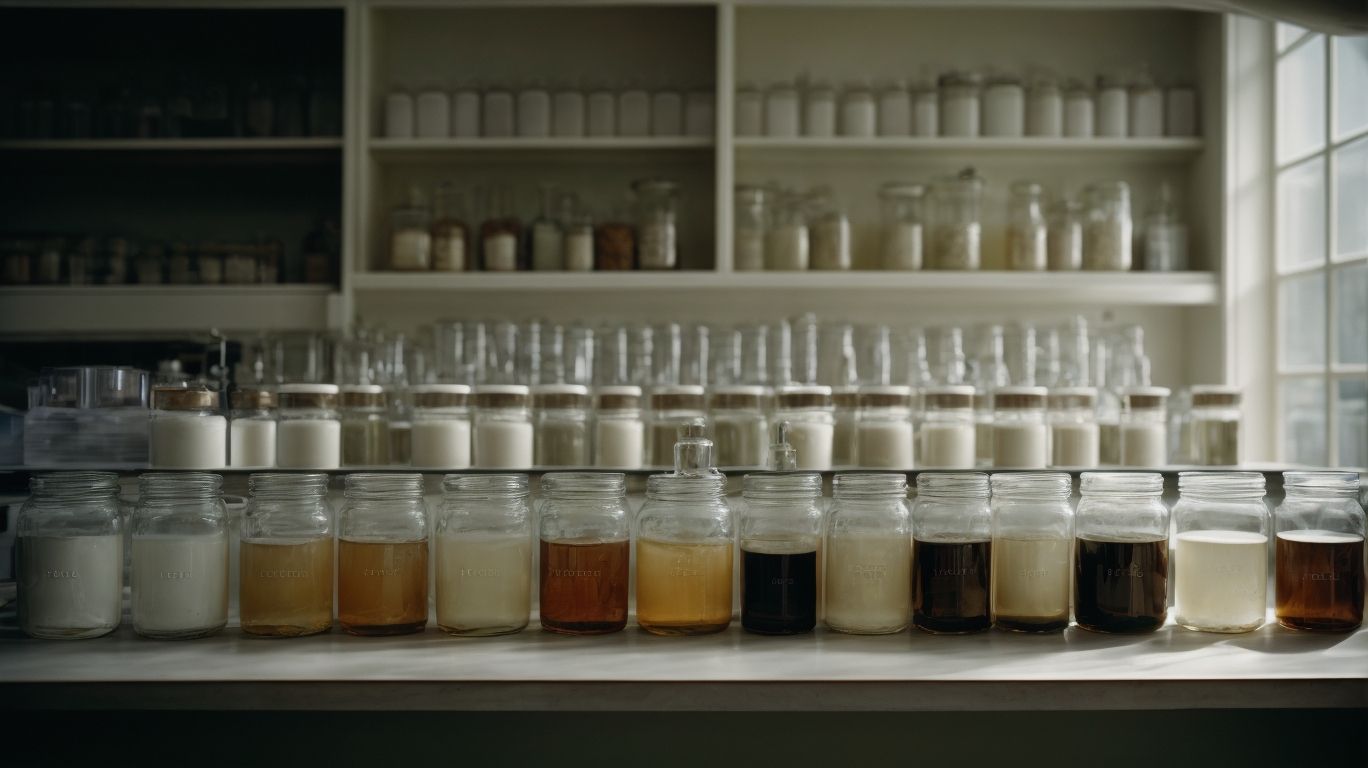Formaldehyde is a colorless, strong-smelling gas that is commonly used in the embalming process to preserve human remains. Classified as a hazardous chemical, formaldehyde has been a subject of controversy in the funeral industry due to its potential risks to human health and the environment. Understanding the role of formaldehyde in embalming, its purpose, and the potential risks associated with its use is crucial for both embalmers and funeral attendees.
Formaldehyde is used in the embalming process as a disinfectant and preservative for the deceased. It is injected into the body’s arteries to replace the blood and other bodily fluids, effectively slowing down the decomposition process. This allows the body to be preserved for viewing during a funeral or memorial service.
The primary purpose of formaldehyde in embalming is to prevent the growth of bacteria and other microorganisms that could cause the body to decay. Other alternatives to formaldehyde, such as glutaraldehyde and phenol, also serve this purpose but may not be as effective. However, these alternatives are not without their own potential risks.
Exposure to formaldehyde can be harmful to both embalmers and the environment. Long-term exposure to the gas has been linked to respiratory issues, neurological disorders, and even cancer. In addition, formaldehyde can also harm the environment by polluting the air and water systems.
To minimize exposure to formaldehyde in the embalming process, proper safety measures must be taken. These include wearing personal protective equipment (PPE), ensuring proper ventilation in the embalming room, and following specific protocols for handling and disposing of formaldehyde.
In the United States, the Occupational Safety and Health Administration (OSHA) and the Environmental Protection Agency (EPA) regulate the use of formaldehyde in the workplace. The legal limit for formaldehyde exposure in the workplace is 0.75 parts per million (ppm) over an eight-hour workday. However, there are currently no regulations on formaldehyde exposure for funeral attendees.
Despite its effectiveness in the embalming process, there are alternatives to formaldehyde that are less toxic and have fewer potential risks. These include using plant-based or natural preservatives, such as essential oils and herbal extracts, as well as refrigeration or dry ice for preservation.
In conclusion, formaldehyde plays a significant role in the embalming process, but its use comes with potential risks. Embalmers must take necessary precautions to minimize exposure and follow regulations to ensure their safety and that of the environment. Additionally, exploring alternative methods of preservation can also reduce the use of formaldehyde in the embalming process.
Key Takeaways:
What is Formaldehyde?

Photo Credits: Chemicalglossary.Net by Paul Roberts
Formaldehyde is a colorless gas with a pungent odor that is commonly used in the embalming process. It is a powerful preservative that aids in preventing decomposition and maintaining the body’s structure during funeral preparations. However, formaldehyde is also considered a carcinogen and can present health risks if not handled correctly. It has the potential to irritate the eyes, nose, and throat, and prolonged exposure may result in respiratory problems and certain types of cancer. As a result, it is crucial for embalmers to take necessary precautions such as wearing gloves and masks, as well as ensuring proper ventilation in the embalming room.
How is Formaldehyde Used in the Embalming Process?

Photo Credits: Chemicalglossary.Net by Timothy Mitchell
Formaldehyde is a crucial element in the embalming process, serving to preserve the deceased and prevent decomposition. Gaining an understanding of the steps involved in using formaldehyde can provide insight into its significance:
- Arterial Embalming: A small incision is made, and a cannula is inserted into an artery, allowing the formaldehyde-based embalming fluid to be pumped into the circulatory system.
- Cavity Embalming: An incision is made in the abdominal area, and a trocar is inserted to puncture organs, draining fluids and injecting the formaldehyde-based solution.
- Surface Embalming: Formaldehyde-based fluids are applied topically to the body’s surface to ensure preservation.
- Hypodermic Embalming: Small incisions are made, and the embalming fluid is injected directly into body tissues.
It is important to note that formaldehyde should be handled with caution due to potential health risks and should only be used by trained professionals in a controlled environment.
What is the Purpose of Formaldehyde in Embalming?

Photo Credits: Chemicalglossary.Net by Daniel Scott
Formaldehyde plays a significant role in the embalming process as it serves to preserve and disinfect the deceased. Its main purpose is to impede the decomposition process by inhibiting the growth of bacteria and fungi. Through a chemical reaction with proteins in the body, formaldehyde creates a cross-linking effect that strengthens tissues and slows decay. However, it is important to note that formaldehyde carries potential risks. Prolonged exposure to high levels of this chemical can lead to respiratory issues and skin irritation. As a result, it is crucial for embalmers to take necessary precautions, such as wearing protective gear and working in well-ventilated areas. A real-life example that highlights the importance of these precautions is the case of a mortician who developed respiratory problems due to repeated exposure to formaldehyde.
What Are the Alternatives to Formaldehyde in the Embalming Process?
There are several alternatives to using formaldehyde in the embalming process that are just as effective in preserving the body while also reducing potential health and environmental risks. These alternatives include:
- Formaldehyde-free embalming fluids: These fluids utilize ingredients such as phenol or glutaraldehyde instead of formaldehyde.
- Essential oil-based embalming fluids: These fluids use essential oils with antimicrobial properties, such as eucalyptus or lavender.
- Non-toxic embalming fluids: Made from natural or plant-based ingredients, these fluids are free from harmful chemicals.
- Refrigeration: In some cases, refrigeration can be used as an alternative to embalming for temporary preservation of the body.
Embalming professionals should carefully consider these alternatives and choose the best option based on their specific needs and preferences.
What are the Potential Risks of Formaldehyde in Embalming?

Photo Credits: Chemicalglossary.Net by Aaron Rodriguez
Formaldehyde, a commonly used chemical in the embalming process, poses potential risks to both embalmers and the environment. Exposure to this chemical can lead to respiratory issues, skin irritation, and eye problems. Additionally, prolonged exposure may increase the risk of certain cancers, such as leukemia and nasopharyngeal cancer.
To mitigate these risks, embalmers should take protective measures, including wearing personal protective equipment (PPE) and working in well-ventilated areas. It is crucial to handle formaldehyde with caution and follow proper safety protocols to minimize potential health hazards associated with its use in embalming.
In the early 20th century, formaldehyde use in embalming became widespread. However, limited knowledge about its health risks led to inadequate safety precautions, resulting in severe health issues for embalmers. As awareness grew, regulations were enacted to protect embalmers and ensure safe working conditions. Today, the embalming industry prioritizes proper training, safety protocols, and the use of alternative preservation methods to reduce the potential risks associated with formaldehyde.
Can Formaldehyde Exposure be Harmful to Embalmers?
Formaldehyde exposure can certainly pose a threat to embalmers. As they handle formaldehyde during the embalming process, they are vulnerable to inhaling or absorbing the chemical through their skin. Prolonged or repeated exposure to formaldehyde can result in various health complications for embalmers, including respiratory issues, irritation of the eyes and throat, and allergic reactions. It may also heighten the likelihood of developing certain types of cancer, such as nasal and lung cancer.
To minimize the risk of exposure, embalmers should adhere to safety precautions such as:
- wearing personal protective equipment
- ensuring proper ventilation in the embalming room
- practicing good hygiene
Can Formaldehyde Exposure be Harmful to the Environment?
Formaldehyde exposure can indeed have negative effects on the environment. When released into the air or water, it can harm plants, animals, and ecosystems. As a volatile organic compound (VOC), formaldehyde contributes to air pollution and can also be detrimental to aquatic life if it enters water bodies. Furthermore, it is a greenhouse gas that contributes to climate change.
To minimize the environmental impact of formaldehyde, it is crucial to properly dispose of and treat embalming fluids containing this chemical. Additionally, exploring alternative embalming methods that reduce or eliminate the use of formaldehyde can help protect the environment.
Can Formaldehyde Exposure be Harmful to Funeral Attendees?
Formaldehyde exposure can pose potential harm to those attending funerals, especially if they are exposed to high levels or for prolonged periods. This strong irritant can cause respiratory issues such as coughing, wheezing, and chest tightness, as well as eye and skin irritation.
To minimize exposure, funeral homes must follow proper ventilation protocols to ensure sufficient airflow in the embalming room. Attendees can protect themselves by limiting their time in the embalming area or wearing protective masks.
Pro-tip: If you are attending a funeral where embalming is performed, consider sitting further away from the embalming area to reduce your risk of exposure.
How Can Formaldehyde Exposure be Minimized in the Embalming Process?

Photo Credits: Chemicalglossary.Net by Henry Allen
To minimize exposure to formaldehyde during the embalming process, it is important to follow these steps:
- Use personal protective equipment (PPE) such as gloves, goggles, and respiratory masks to avoid direct contact and inhalation of formaldehyde.
- Ensure proper ventilation in the embalming room by opening windows or using exhaust fans to remove formaldehyde fumes.
- Limit the amount of formaldehyde used by utilizing alternative preservation techniques or reducing the concentration in embalming fluids.
- Follow appropriate handling and disposal procedures for materials containing formaldehyde to prevent any leaks or spills.
- Implement regular training and education for embalmers on safe handling practices and the potential risks associated with exposure to formaldehyde.
What Safety Measures Should be Taken by Embalmers?
To ensure their safety from formaldehyde exposure, embalming professionals should follow several important safety measures. These include:
- Using Personal Protective Equipment (PPE) such as gloves, goggles, and aprons.
- Ensuring proper ventilation in the embalming room to minimize inhalation of formaldehyde fumes.
- Handling formaldehyde in a well-ventilated area or under a fume hood.
- Storing formaldehyde in designated containers and areas.
- Following proper waste disposal protocols for formaldehyde-contaminated materials.
- Regularly monitoring formaldehyde levels in the embalming room.
- Receiving appropriate training on the safe handling and use of formaldehyde.
How Can Proper Ventilation be Ensured in the Embalming Room?
To ensure the safety and well-being of embalmers and minimize their exposure to formaldehyde, it is crucial to have proper ventilation in the embalming room. Here are some steps that can be taken to ensure proper ventilation:
- Install an effective exhaust system to remove formaldehyde vapors.
- Regularly maintain and clean the exhaust system to ensure it remains efficient.
- Ensure that the embalming room has adequate fresh air intake to dilute and replace contaminated air.
- Use air monitoring equipment to regularly check the levels of formaldehyde and ensure they are within acceptable limits.
- Train embalmers on proper ventilation practices and the use of personal protective equipment.
What Regulations are in Place for the Use of Formaldehyde in Embalming?

Photo Credits: Chemicalglossary.Net by Anthony Thomas
Formaldehyde, a common ingredient in embalming fluids, is subject to regulation by various agencies in order to ensure safety. In the United States, the Occupational Safety and Health Administration (OSHA) imposes limits on formaldehyde exposure in the workplace. Funeral homes are required to follow these regulations in order to protect the health of embalmers and other workers. Furthermore, the Environmental Protection Agency (EPA) controls the release of formaldehyde into the environment. Funeral homes must properly dispose of embalming fluids to minimize their impact on the environment. Adhering to these regulations is crucial in order to protect both workers and the environment.
Suggestions for further regulation could include:
- Regular monitoring and testing
- Ongoing research into alternative embalming methods
What Organizations Regulate the Use of Formaldehyde in Embalming?
The use of formaldehyde in embalming is closely monitored by several organizations to ensure safety and minimize potential risks. These organizations include:
- Occupational Safety and Health Administration (OSHA): OSHA is responsible for setting and enforcing standards to protect workers from exposure to hazardous substances, including formaldehyde. They provide guidelines for the safe handling, storage, and use of formaldehyde in embalming.
- Environmental Protection Agency (EPA): The EPA regulates the disposal of formaldehyde-containing embalming fluids to protect the environment. They establish guidelines for proper waste management and disposal practices.
- Funeral and cemetery regulatory agencies: These state or local agencies oversee the funeral industry and may have specific regulations related to the use of formaldehyde in embalming. They ensure that funeral homes and embalmers adhere to proper safety protocols.
Pro-tip: It is crucial for embalmers to stay updated on the regulations and guidelines provided by these organizations to ensure safe and compliant embalming practices. Regular training and education can help maintain a high level of safety and minimize exposure risks.
What are the Legal Limits for Formaldehyde Exposure in the Workplace?
The regulation of formaldehyde exposure in the workplace is overseen by various organizations. In the United States, the Occupational Safety and Health Administration (OSHA) sets a permissible exposure limit (PEL) of 0.75 parts per million (ppm) for formaldehyde over an 8-hour workday. OSHA also has a short-term exposure limit (STEL) of 2 ppm over a 15-minute period. The American Conference of Governmental Industrial Hygienists (ACGIH) recommends a threshold limit value (TLV) of 0.3 ppm for formaldehyde. It is crucial to adhere to these limits to ensure the safety and well-being of workers who may come into contact with formaldehyde in the workplace.
Are There Any Alternatives to Formaldehyde for Embalming?
Are There Any Alternatives to Formaldehyde for Embalming?
There are alternatives available for embalmers when it comes to embalming, including formaldehyde-free embalming fluids. These alternatives are gaining popularity due to growing concerns about the health risks associated with formaldehyde exposure. Some of these alternatives utilize naturally derived ingredients, such as plant-based substances or essential oils, while others use synthetic chemicals that are less harmful. Embalmers should consider these alternatives in order to minimize their exposure to formaldehyde and create a safer working environment.
A pro-tip: It is crucial for embalmers to stay informed about new developments in embalming techniques and products to ensure they are utilizing the most effective and safest methods available.
Frequently Asked Questions
What is formaldehyde and how is it used in the embalming process?
Formaldehyde (CH₂O) is a colorless, highly toxic, and flammable gas commonly used as an embalming fluid to preserve the deceased for viewing and funeral services. It works by preventing the growth of bacteria and other organisms that can cause decay.
What are the potential health risks associated with formaldehyde exposure for funeral directors and embalmers?
Exposure to formaldehyde can irritate the skin, throat, lungs, and eyes, and repeated exposure can potentially lead to cancer. It is important for funeral directors and embalmers to follow safety measures to minimize the risks of exposure.
What are the safety measures recommended by NIOSH for controlling formaldehyde exposures during embalming?
NIOSH recommends using Hierarchy of Controls, which includes measures such as exposure monitoring, engineering controls, personal protective equipment, work practices, training, medical surveillance, and recordkeeping.
What is the OSHA Formaldehyde Standard and how does it apply to funeral directors?
The OSHA Formaldehyde Standard (29 CFR 1910.1048) outlines permissible exposure limits (PELs) for formaldehyde, which funeral directors must adhere to. The PEL is 0.75 parts per million (ppm) as an 8-hour time-weighted average (TWA).
How can funeral directors ensure compliance with the OSHA Formaldehyde Standard and promote a safe working environment?
To ensure compliance with the OSHA Formaldehyde Standard, funeral directors should watch the video prepared by Jerome P. Flesch, Michael G. Gressel, and Rosmarie T. Hagedorn, which offers valuable insights and practical tips. Additionally, following safety measures such as proper ventilation and personal protective equipment can help promote a safe working environment.
What resources are available for workers and employers to address formaldehyde exposure in the workplace?
NIOSH provides resources such as the NIOSH Pocket Guide to Chemical Hazards (NPG) and the NIOSH Manual of Analytical Methods (NMAM) to help workers and employers recognize and control workplace chemical hazards. NIOSHTIC-2, a searchable database of worker safety and health publications, documents, grant reports, and journal articles, is also available.
